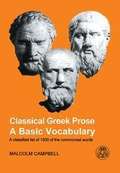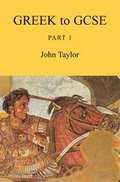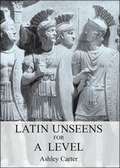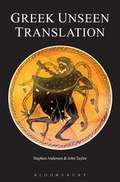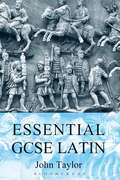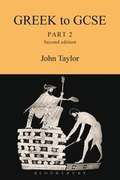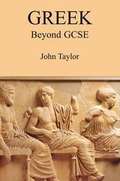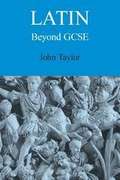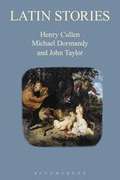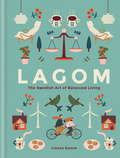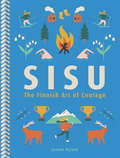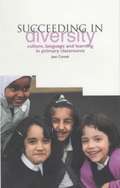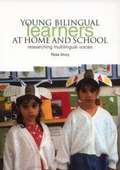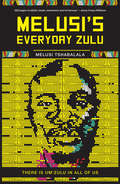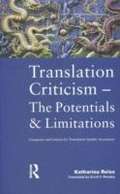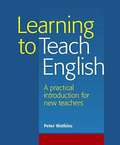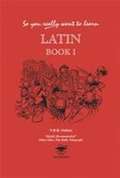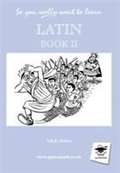- Table View
- List View
Classical Greek Prose: A Basic Vocabulary (PDF)
by Malcolm CampbellThis handbook contains a classified list, with English equivalents, of 1500 words in common use among classical Greek historians, orators and philosophers. One hundred of these are dealt with at greater length in a supplement, which also focuses on a number of crucial idioms. The aim of the book is that learners drilled in these words over the course of a semester or two should find that they can read the texts of such authors as Thucydides, Plato and Demosthenes with a high degree of fluency. An alphabetical index is provided.
Greek To GCSE (PDF)
by John TaylorThis course was written in response to a JACT (Joint Association of Classical Teachers) survey of over 100 schools. It offers a fast-track route to GCSE for those with limited time. It is based on experience of what pupils find difficult, concentrating on the essentials and on the understanding of principles in both accidence and syntax: minor irregularities are postponed and subordinated so that the need for rote learning is reduced. It aims to be user-friendly, but also to give pupils a firm foundation for further study. The course has been tested and refined in 15 schools over the last three years. Part 1 covers the basics: the main declensions, a range of active tenses and a vocabulary of 275 Greek words to be learned. Pupil confidence is built up by constant consolidation of the material covered. After the preliminaries, each chapter concentrates on stories with one source or subject: Aesop, the "Odyssey" and Alexander the Great. Part 1 is self-contained, with its own reference section.
Latin Unseens For A Level (PDF)
by Ashley CarterThis collection of Latin unseen passages forms a companion volume to Latin Momentum Tests for GCSE, and is intended to be used similarly by students preparing for examinations at AS, A2 and AEA levels. The largest section is set at AS level and comprises prose passages forming a coherent story based on original sources but simplified to maintain a level of difficulty appropriate for this level. A knowledge of a typical vocabulary list of about 1000 words is assumed. Most of the rest of the passages are, with rare exceptions, unadapted Latin, both prose and verse, taken from the authors used in the examinations. Difficult or rare words are glossed. The last few passages are of a standard of difficulty appropriate to AEA level. All passages are of a similar length and format to those used in the examinations. One sample mark scheme has been included to give teachers and students some insight into how these unseens are marked in the examinations.
Greek Unseen Translation (PDF)
by Stephen Anderson John TaylorA new collection of 120 passages from Greek authors. The first half contains twenty adapted passages building up to GCSE level, thirty lightly adapted ones for AS, and ten easy unadapted passages to introduce the translation of verse. The second half contains thirty prose and thirty verse passages of A2 standard, unadapted except by minor omissions. Vocabulary beyond the core assumed at each level is glossed.
Essential GCSE Latin (PDF)
by John TaylorOCR is the only board in that offers a GCSE in Latin language. This title offers summary of the linguistic requirements for the OCR Examination Board specification, aimed mainly at pupils in their GCSE year. It contains examples and practice sentences (600) on each point, as well as cross-referencing.
Greek To GCSE (PDF)
by John TaylorThe two-volume course "Greek to GCSE" was written in response to a JACT survey of over 100 schools and first published in 2003. The course offer a fast-track route to GCSE for those with limited time. It is based on experience of what pupils find difficult. It concentrates on the essentials, and on the understanding of principles in both accidence and syntax. It aims to be user-friendly, but also to give pupils a firm foundation for further study. Part 1 covered the basics: the main declensions, a range of active tenses, and a vocabulary of 275 Greek words to be learned. Part 2, here issued in a new edition, introduces a wider range of grammatical forms and constructions. This revised edition has been adapted to complete the coverage of requirements for the current GCSE, expanding vocabulary to 480 words. Reading material moves from Socrates and the Sophists to the world of myth, and finally to extended passages of lightly adapted Herodotus. Practice passages and revision sentences for GCSE complete Part 2, which has a reference section covering the whole course.
Greek Beyond GCSE (PDF)
by John TaylorGreek Beyond GCSE covers all the linguistic requirements for the OCR AS-level in Ancient Greek, and aims to bring students to a point where they can tackle original Greek texts with confidence. It is designed as continuation of Greek to GCSE, but is self-contained and can be used independently. The first part of the book introduces new constructions accompanied by exercises and lightly adapted reading passages. This is followed by extended unadapted extracts from a range of prose authors. Finally, there is a reference section including a summary of all constructions, a comprehensive grammar, and a vocabulary of 830 Greek words.
Latin Beyond GCSE (PDF)
by John TaylorLatin Beyond GCSE covers all the linguistic requirements for the OCR AS-level in Latin, and the grammar for A2. The first part of the book introduces new constructions and the translation of sentences from English to Latin, with practice passages for unseen translation at AS standard. The next section introduces the translation and scansion of verse, and includes passages for unseen translation and comprehension at A2 standard in both prose and verse. This is followed by longer unadapted extracts from a range of prose authors. Finally there is a reference section including a summary of all constructions, a comprehensive grammar, and a vocabulary of 1000 Latin words (with an additional list of 250 common poetic words for A2 verse passages).
Latin Stories: A GCSE Reader (PDF)
by John Taylor Henry Cullen Michael DormandyLatin Stories is an ideal first reader for students of Latin. It offers 100 self-contained passages of manageable length, chosen for their intrinsic interest and adapted from a wide range of ancient authors. Generous help is given, with a short introduction to each story and glossing of all proper names and non-GCSE vocabulary. The collection will also be attractive to older students beginning or returning to the language. Section 1 provides 30 passages, starting with very short and simple stories and building up to the level of the current OCR GCSE paper Language 1. Section 2 provides 30 passages at the level of the GCSE paper Language 2, with its more demanding grammar and vocabulary requirements. Section 3 provides 40 longer passages in the style of current GCSE papers, with comprehension questions as well as sections for translation: 20 for Language 1 (stories from mythology or Roman life) and 20 for Language 2 (stories from Greek and Roman history).
Lagom: The Swedish Art of Balanced Living
by Linnea DunneStep aside Hygge. Lagom is the new Scandi lifestyle trend taking the world by storm. This delightfully illustrated book gives you the lowdown on this transformative approach to life and examines how the lagom ethos has helped boost Sweden to the No.10 ranking in 2017's World Happiness Report. Lagom (pronounced 'lah-gom') has no equivalent in the English language but is loosely translated as 'not too little, not too much, just right'. It is widely believed that the word comes from the Viking term 'laget om', for when a mug of mead was passed around a circle and there was just enough for everyone to get a sip. But while the anecdote may hit the nail on the head, the true etymology of the word points to an old form of the word 'lag', which means 'law'.Far from restrictive, lagom is a liberating concept, praising the idea that anything more than 'just enough' is a waste of time. Crucially it also comes with a selflessness and core belief of responsibility and common good. By living lagom you can: Live a happier and more balanced life Reduce your environmental impact Improve your work-life balance Free your home from clutter Enjoy good food the Swedish way Grow your own and learn to forage Cherish the relationships with those you love
Sisu: The Finnish Art of Courage
by Joanna NylundDiscover the Finnish quality of sisu and how cultivating it can help you lead a life of greater purpose and happiness.This ancient Finnish word describes an attitude of courage, resilience, grit, tenacity and perseverance. This key psychological competence enables extraordinary action in times of adversity. To have sisu confers a further dimension of doing so with honesty, integrity and humility.By cultivating sisu you can: Face life's challenges with courage and determination Enhance your wellbeing and find your focus Communicate confidently and resolve conflicts effectively Cultivate endurance and achieve your fitness goals Raise kind and resilient children Act with integrity and fight for what you believe inSisu is a universal trait. It may have been bottled and labelled by the Finns, but it is within reach of everyone. It lies within you, and you are very likely to have used it already.
Succeeding In Diversity: Culture, Language And Learning In Primary Classrooms (PDF)
by Jean ContehJean Conteh traces a group of successful bilingual learners as they progress through Key Stage 2 in mainstream classrooms to show how successful children are helped by their interactions and experiences at home and school to move confidently between social worlds, cultures and languages in their daily lives. These are the fortunate children: the skills, knowledge and strategies they display in all these interactions are, as Dr Conteh describes, recognized and valued in classroom pedagogy and in assessing their achievements in school. But they are the exception - most bilingual learners are still condemned to failure in school. The implications for educational policy, teacher education and classroom practice of this case study are set out and linked in new ways with established knowledge and ideas about linguistics, learning and language in the mainstream classroom. Supported with practical suggestions and resources, this book should enable primary teachers to provide what bilingual children in their class need to learn successfully.
Young Bilingual Learners at Home and School: Researching Multilingual Voices (PDF)
by Rose DruryBased on the author's ethnographic study, this book examines the experiences of three four-year-old bilingual children as they begin school in three English nursery classes. It thus provides insights into young children's use of first languages as well as English, so provides a fuller and richer picture of bilingual children's learning. The book reveals some of the ways young bilingual children experience nursery as they begin to learn the language required for formal schooling. It demonstrates how they take control of their own learning at home. And it asks questions: How do Samia, Maria and Nazma find their own way through nursery? What are their individual strategies for getting by and, beyond that, for learning during their first year of formal schooling? How do they syncretise home and school learning? The detailed picture that emerges fills in the detail missing from the current over-generalised view of bilingual children in the early years and provides an important new perspective to a growing body of literature on young bilinguals. It will be essential reading for all teachers, early childhood practitioners and early years policy makers operating in multilingual environments.
Collins Easy Learning French Dictionary (Volume 4 of 6) (PDF)
by Horst KopleckVolume 4 of 6: English to French - A to F The font size in this large print edition is 18 point. This dictionary provides beginners of French with the easiest way to learn the language. Its features include full coverage of core vocabulary in both French and English, thousands of examples to show how to use the translations and all essential set expressions. The layout is clear and user-friendly.
Collins Easy Learning French Dictionary (Volume 5 of 6) (PDF)
by Horst KopleckVolume 5 of 6: English to French - G to P The font size in this large print edition is 18 point. This dictionary provides beginners of French with the easiest way to learn the language. Its features include full coverage of core vocabulary in both French and English, thousands of examples to show how to use the translations and all essential set expressions. The layout is clear and user-friendly.
Collins Easy Learning French Dictionary (Volume 3 of 6) (PDF)
by Horst KopleckVolume 3 of 6: French to English - P to Z. The font size in this large print edition is 18 point. This dictionary provides beginners of French with the easiest way to learn the language. Its features include full coverage of core vocabulary in both French and English, thousands of examples to show how to use the translations and all essential set expressions. The layout is clear and user-friendly.
Collins Easy Learning French Dictionary (Volume 6 of 6) (PDF)
by Horst KopleckVolume 6 of 6: English to French - Q to Z. The font size in this large print edition is 18 point. This dictionary provides beginners of French with the easiest way to learn the language. Its features include full coverage of core vocabulary in both French and English, thousands of examples to show how to use the translations and all essential set expressions. The layout is clear and user-friendly.
Collins Easy Learning German Dictionary (Volume 2 of 6) (PDF)
by CollinsVolume 2 of 6: German to English - G to R. The font size in this large print edition is 18 point. This dictionary provides beginners of German with the easiest way to learn the language. Its features include full coverage of core vocabulary in both German and English, thousands of examples to show how to use the translations and all essential set expressions. The layout is clear and user-friendly. The Collins Easy Learningnbsp;Frenchnbsp;and Spanish dictionaries are also available.
Collins Easy Learning German Dictionary (Volume 2 of 6) (PDF)
by CollinsVolume 2 of 6: German to English - G to R. The font size in this large print edition is 18 point. This dictionary provides beginners of German with the easiest way to learn the language. Its features include full coverage of core vocabulary in both German and English, thousands of examples to show how to use the translations and all essential set expressions. The layout is clear and user-friendly. The Collins Easy Learningnbsp;Frenchnbsp;and Spanish dictionaries are also available.
Melusi’s Everyday Zulu: There is um’Zulu in all of us
by Melusi TshabalalaDuduza. Bopha. Imbiza. Phapha. Asixoliseni. Amapopeye . . . What is the power of a single word?Six days a week, advertising creative Melusi Tshabalala posts a Zulu word on his Everyday Zulu Facebook page and tells a story about it. His off-beat sense of humour, razor-sharp social observations and frank political commentary not only teaches his followers isiZulu but also offer insight into the world Melusi inhabits as a 21st century Zulu man.Over the past few months he has built up a big and a loyal following that include radio host Jenny Crwys-Williams and Afrikaans author Marita van der Vyfer. He pokes fun at our differences and makes us laugh at ourselves and each other.Melusi asks critical questions of everyone, from Aunty Helen, Dudu-Zille to Silili (Cyril Ramaphosa) and even Woolworths (why are their aircons always set on ‘jou moer’?) His fans love him for his honesty and commitment to pointing out subtle and overt forms of prejudice and racism.Melusi’s Everyday Zulu holds up a mirror that shows South African society in all its flaws and its sheer humanity. Most importantly, he shows the power of words and that there’s um’zulu in all of us!
Dyslexia, Languages and Multilingualism (PDF)
by John EverattPopulations are becoming more mobile, leading to sometimes dramatic changes in societies. These changes can lead to classrooms in which children speak a home/first language that is different from the language of education. In places of relatively large immigration, there may be a range of home/first languages spoken by children in a local school – in one, near to the University of Canterbury, New Zealand, over a dozen first languages were spoken by young children in a recent class, despite English being the only language spoken by their teacher.
Translation Criticism: Categories and Criteria for Translation Quality Assessment (PDF)
by Katharina ReissKatharina Reiss's now classic contribution to Translation Studies, Mglichkeiten und Grenzen der bersetzungskritik: Kategorien und Kriteren fr eine sachgerechte Beurteilung von bersetzungen, first appeared in 1971. This is the first English translation of this major work, allowing students and practitioners of translation in the English-speaking world to make more extensive use of Reiss's pioneering treatment of a central theme in translation: how to develop reliable criteria for the systematic evaluation of translations. Using a wealth of interesting and varied examples, Reiss offers a systematic and illuminating text typology, a pragmatic approach to text analysis, a functional perspective on translation and a hermeneutic view of the translator, thus accounting for some of the most important aspects of the translation process: the text (both source and target versions), the conditions which determine the translator's decisions, and the translator as an individual whose personal interpretation has to be respected by any critic. In the three decades since Katharina Reiss wrote, the terminology of translation studies has evolved on many fronts. Erroll Rhodes' translation strikes an optimal balance between remaining faithful to the original presentation and using terminology that today's reader would generally understand and value.
Learning to Teach English: A Practical Introduction for New Teachers (PDF)
by Peter WatkinsLearning to Teach English Second Edition (2014) is now available. The second edition is thoroughly revised and comes with a DVD, including recordings of real lessons.
So You Really Want to Learn Latin: Book 1 (PDF)
by Oulton, N. R. R.This is the first part of a no-nonsense, grammatically based Latin course which has proved immensely popular with schools since its publication in 1999. Ideal for pupils of all abilities, Book I introduces pupils to regular verbs in all six active tenses, nouns of the first three declensions, sum, adjectives of the 1st/2nd declension, prepositions, numerals and the history of Rome from Aeneas to Cloelia.
So You Really Want to Learn Latin: Book II (PDF)
by Oulton, N. R. R.Book II takes pupils through 3rd declension adjectives, personal and demonstrative pronouns, relative clauses, 4th and 5th declension nouns, the passive voice, the comparison of adjectives and adverbs, irregular verbs and the history of Rome from Coriolanus to the 2nd Punic War. A thorough grounding for pupils attempting Level 2 of Common Entrance, this book completes the essential preliminary groundwork for the GCSE course
